The Volokh Conspiracy
Mostly law professors | Sometimes contrarian | Often libertarian | Always independent
What if Supreme Court terms were already governed by term limits?

Some scholars have proposed placing term limits on Supreme Court justices as a means of, among other things, reducing the partisan rancor over judicial appointments. Orin Kerr and I discuss these proposals in posts below. Orin recommends the idea. I think the idea is worthwhile, but also have some doubts.
In this brief post I thought it would be worthwhile to say something about the Supreme Court's composition were it already governed by term limits. One clear consequence of this sort of proposal would be that the court would more directly follow the election returns. That is, one could determine the likely makeup of the court simply by looking at party control of the president and (perhaps) party control of the Senate. (The reason I say "perhaps" is that the relevance of party control is dependent upon the extent to which one believes the Senate would constrain the president's choice of who to nominate.)
The most common term limit proposal is for staggered terms of 18 years. This would mean that (barring the death or sudden resignation of a justice) there would be two Supreme Court nominations per presidential term. Control of the court would be a consequence of which party controlled the White House during the preceding 18 years. So, if such a proposal were in effect today, Democratic nominees would hold a 5-4 majority on the court, as there have been Democratic presidents for 10 of the past 18 years.
If the term limit were longer - say, 27 years, with a new nomination every three years - it would not alter the result, as there have been Democratic presidents for 15 of the past 27 years. Lengthening the term to 36 years, however, so that there would be just one Supreme Court nomination per term, would yield a 5-4 majority of Republican nominees. Note, however, that with a longer term, the likelihood of a mid-term vacancy due to death, disability or some other factor would increase - and an increase in the likelihood of mid-term vacancies likely reduces the potential benefits of a term limit rule.
In the above calculations, I have not accounted for party control of the Senate. This is because I am not entirely sure how the Senate would treat presidential nominees under a term limit proposal. I would hope that allowing for nominations on a set, predictable schedule would reduce the likelihood of Senate obstructionism, but it is certainly possible that this reform would produce more centrist or "consensus" nominees when the Senate is controlled by the opposing party. This would undoubtedly affect the composition of the court, but I am not sure precisely how to model that (at least for the purposes of a brief blog post).
One other point worth noting is that the adoption of a term limit proposal for Supreme Court nominations could also have an effect on presidential elections. That is, the knowledge that each president would have two Supreme Court nominations per term - and the ability to predict which seats those nominations would fill - could likely affect votes and turnout, and could thus affect the outcome in close elections. Indeed, I suspect that if Senate Republicans refuse to confirm an Obama nominee to the court this year, it will affect the results in November one way or the other.
Show Comments (0)